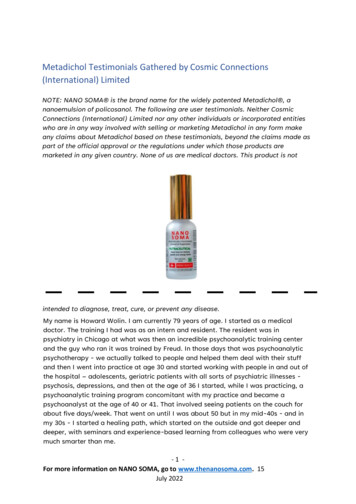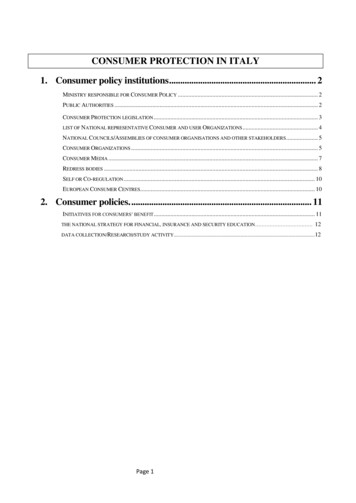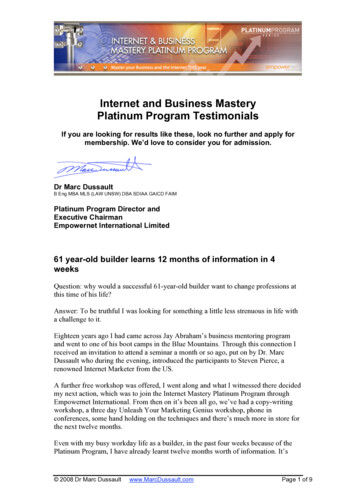
Transcription
Effects of Consumer Testimonials inWeight Loss, Dietary Supplement andBusiness Opportunity AdvertisementsReport submitted to Federal Trade CommissionManoj Hastak, Ph.D.Michael B. Mazis, Ph.D.September 22, 2004
Effects of Consumer Testimonials in Weight Loss,Dietary Supplement and Business Opportunity AdvertisementsIntroductionA research study was designed to investigate the effects on consumers of testimonials inprint advertisements. Some of the questions addressed in the study were:CDo consumers interpret testimonials to imply that the product will enable newusers to achieve results similar to those portrayed by the testimonialists in theadvertisement?CDo consumers interpret testimonials to imply that the product will enable asubstantial proportion of new users to achieve results similar to those portrayedby the testimonialists in the advertisement? In other words, do testimonialscommunicate “typicality”?CDo disclosures moderate the effects of testimonials on communication of thesemessages?MethodSixteen hundred and twenty-four (1624) interviews were conducted in 12 geographicallydiverse markets: Arlington, VA; Austin, TX; Boston, MA; Chicago, IL; Colorado Springs, CO;Edison, NJ; Los Angeles, CA; Poughkeepsie, NY; Schenectady, NY; Orlando, FL; Toledo, OH;and Wichita, KS. Respondents were exposed to an ad for a fictitious brand of either a weightloss program (WeightGuard), a dietary supplement for lowering cholesterol, (Cardio Guard), or abusiness opportunity (Vending Solutions). (See Appendix A for the ads.) Five hundred andeighty-two (582) interviews were conducted for the weight loss program; 522 interviews wereconducted for the dietary supplement, and 520 interviews were conducted for the businessopportunity (vending machine business). Interviews were conducted in shopping malls betweenNovember 2002 and February 2003. The study was “double blind”; neither the interviewers norPage 1 of 13
the respondents were aware of the identity of the client or the purpose of the study. Respondentswere paid 2.00 for their participation in the study.DesignThe study consisted of two sub-designs -- one for the weight loss program and the otherfor the dietary supplement and business opportunity. In the sub-design for the weight lossprogram, all respondents saw an advertisement consisting of five testimonials by individualswho stated that they had experienced weight loss using WeightGuard. Two variables weremanipulated: the amount of weight loss claimed by the testimonialists (two levels: 24-36 poundsand 48-72 pounds) and the disclosure included in the ad (four levels: no disclosure, “Results nottypical,” “These testimonials are based on the experiences of a few people. You are not likely tohave similar results,” and “The average WeightGuard user loses about 10 pounds in threemonths”).1 In addition, there was one “no numbers” condition: the testimonialists reportedresults that were not quantified (e.g., “WeightGuard has made a difference. I have lost weight inthe short time since I started.”) and there was no accompanying disclosure.In the sub-design for the dietary supplement and business opportunity, the averagecholesterol loss claimed was 60 points and the average money made was 2400 per month,respectively. Four variables were manipulated: product type (two levels: dietary supplementand business opportunity), testimonial message (two levels: single testimonial and fivetestimonials), variance in results reported by the five testimonialists (two levels: low variance1The disclosures were prominently displayed in the ads, the lettering was in red, bold, 14 pointtype, and a red asterisk was used in the text of the ad to call attention to the disclosure.Page 2 of 13
and high variance),2 and the disclosure included in the ad (two levels: no disclosure and “Resultsnot typical”). There were four additional conditions (two for each product): two “companyassertion” conditions involving a claim made by the company (e.g., “Daily use of Cardio Guardlowers cholesterol levels by 60 points”) without testimonials; and two “no numbers” conditionsin which five testimonialists reported results that were not quantified (e.g., “Thank you, thankyou, thank you! My cholesterol has gone down.”). There was no disclosure in any of these fourconditions.Screening ProcedureInterviewers used a “screening” questionnaire, which consisted of questions to determinewhether potential respondents were qualified to participate in the study (Appendix B). Potentialrespondents were excluded from participation if they or members of their households worked foran advertising agency, a public relations firm, a marketing research firm, or a store in theshopping mall. In addition, potential respondents were excluded if they had participated in amarketing research survey other than a political poll in the past six months. They were alsoexcluded if they wore eyeglasses or contact lenses for reading but did not have their correctiveeye wear with them at the time of the interview.Potential respondents were further screened with some product-specific questions. Forthe weight loss program, potential respondents had to have tried to lose weight or gone on a dietin the last 12 months and used a weight-loss product, plan, or program. In addition, potentialrespondents were excluded if they or members of their households worked for a store or2In the low variance condition, the testimonials all claimed similar results (cholesterol loweringranged from 54 to 66 points; money making ranged from 2200 to 2600 per month). In thehigh variance condition, the testimonials varied more (cholesterol lowering ranged from 30 to 90points; money making ranged from 1200 to 3600).Page 3 of 13
company that markets a weight-loss product, medication, or program. For the dietarysupplement product, potential respondents had to have been “concerned” or “very concerned”about their cholesterol level and to have done something to help lower or maintain theircholesterol level. In addition, potential respondents were excluded if they or members of theirhouseholds worked for a store or company that markets pharmaceutical products or were in thehealth care or medical field. For the business opportunity, potential respondents either had tocurrently operate or be interested in operating a small business. In addition, potentialrespondents were excluded if they or members of their households worked for a company thatmarkets new business opportunities or were in the accounting/financial services field.Age and gender quotas were established for each of the three products based ondemographic data about the potential target audience. For the weight-loss program, the agequota was half 18-44 years old and half 45 years and older, and the gender quota was one-thirdmale and two-thirds female. For the cholesterol-lowering dietary supplement, the age quota wasone-third 18-44 years old and two-thirds 45 years and older, and the gender quota was half maleand half female. For the business opportunity, the age quota was half 18-44 years old and half45 years and older, and the gender quota was two-thirds male and one-third female.Those potential respondents who were qualified to participate in the study based on theirresponses to the screening questionnaire and who satisfied the age/sex quotas were administeredthe main questionnaire.Main QuestionnaireThe main questionnaires for the three products followed the same format (Appendix C).Respondents were interviewed individually. They were given a one-page print advertisement fora hypothetical product and asked to “read it carefully and let me know when you are finished.”Page 4 of 13
The advertisement was then removed from sight. Then, respondents were asked a series ofopen-ended and closed-ended ad communication questions. Respondents were told “If you don’tknow an answer, that’s o.k., just say “I don’t know.”ResultsWeight Loss ProgramAd CommunicationRespondents exposed to an ad for the weight loss program were asked the followingquestion:Q3.Did or didn’t what you just read suggest anything about the number ofpounds that new users of WeightGuard can expect to lose in 3 months?Respondents who said “yes, it did” were then asked a follow-up question:3Q3a.What was suggested about the number of pounds that new users ofWeightGuard can expect to lose in 3 months?Respondents who gave a non-numerical response (e.g., “a lot of weight”) to Q3a were asked anadditional question:Q3b.Could you be more specific about the number of pounds that new users ofWeightGuard can expect to lose in 3 months?For respondents who gave a single numerical response to Q3a or Q3b (e.g., “30pounds”), that numerical response was used as a measure of ad communication. For respondentswho gave multiple numerical responses to Q3a or Q3b (e.g., “30 to 36 pounds”), the lowest3Of the 514 respondents who were exposed to the WeightGuard ad with testimonials that werequantified, 419 (81.5%) said “yes, it did” to Q3 and therefore, were asked Q3a. Similar resultswere obtained for the dietary supplement and business opportunity ads. For all three products,there were no differences in the % of “yes, it did” responses for respondents in the “nodisclosure” conditions as compared to respondents in the “results not typical” and “experiencesof a few” disclosure conditions.Page 5 of 13
numerical response was used as a conservative measure of ad communication.Table 1 presents the findings. For each treatment condition, the table shows thepercentage of respondents indicating that the ad suggested that new users of WeightGuard canexpect to lose at least a specific amount of weight (at least 10 pounds, at least 20 pounds, etc.) inthree months. These results show that:CThe ads communicated to a substantial percentage of respondents that theadvertised product would enable new users to achieve results similar to thoseportrayed by the testimonialists in the advertisements. For example, in theabsence of a disclosure, 58% of the respondents exposed to the 24-36 poundweight loss ad with multiple testimonials indicated the ad communicated that newusers of the product could expect to lose at least 24 pounds. In addition, in theabsence of a disclosure, 69% of the respondents exposed to the 48-72 poundweight loss ad with multiple testimonials indicated the ad communicated that newusers of the product could expect to lose at least 48 pounds.CThe “results not typical” and “experiences of a few” disclosures did notsignificantly reduce these proportions for the 24-36 pound ad.4 Although bothdisclosures reduced these proportions significantly for the 48-72 pound ad, asubstantial proportion of respondents still took a significant weight loss claim.For example:CC55% of respondents exposed to the “results not typical” disclosureindicated the 48-72 pound ad communicated that new users could expectto lose at least 48 pounds.C48% of respondents exposed to the “experiences of a few” disclosureindicated the 48-72 pound ad communicated that new users could expectto lose at least 48 pounds.The data were quite different for the “average 10 pounds” disclosure. It was moreeffective than the other two disclosures in reducing the percentage of respondentssaying that the advertised product would enable new users to achieve resultssimilar to those portrayed by the testimonialists in the advertisements. Forexample, the percentage of respondents exposed to the “average 10 pounds”disclosure in the 24-36 pound ad who said that new users could expect to lose at4Each treatment condition or cell had about 65 respondents. Therefore, differences betweentreatment conditions may not have achieved statistical significance because of these modest cellsizes.Page 6 of 13
least 24 pounds (38%) was substantially less than for the other two disclosureconditions (75% and 76%). There were similar results for the 48-72 pound ad;the percentage of respondents exposed to the “average 10 pounds” disclosure whosaid new users could expect to lose at least 48 pounds was 15% compared to 55%and 48% for the other two disclosure conditions. However, the data also showthat a substantial proportion of respondents still took claims of weight losssignificantly higher than the 10 pounds mentioned in the disclosure. Forexample:C42% respondents exposed to the “average 10 pounds” disclosure in the 24 36 pound ad said that new users could expect to lose at least 20 pounds.C27% respondents exposed to the “average 10 pounds” disclosure in the 48 72 pound ad said that new users could expect to lose at least 20 poundsCommunication of TypicalityRespondents who indicated that the ad communicated a quantitative weight loss claim(i.e., said “yes” to Q3) and provided a single numerical response were then asked the “typicality”question for the numerical response they provided (Q3c). Those respondents who provided morethan one numerical response were asked the “typicality” question for the lowest and highestnumbers they provided (Q3d and Q3e):Q3c/d/e:Based on what was suggested, how many new users ofWeightGuard can expect to lose at least pounds in threemonths?Respondents were provided with the following response options: “all,” “almost all,” “most,”“about half,” “some,” “very few,” “none,” or “don’t know or not sure.”Table 2 presents the data for the “typicality” measure. The table shows, for eachtreatment condition, the percentage of respondents indicating that the ad suggested thatall/almost all/most/about half of new users of WeightGuard can expect to lose at least a specificamount of weight (at least 10 pounds, at least 20 pounds, etc.). These results show that:CA substantial proportion of the respondents exposed to the 24-36 pound weightloss ad without any disclosure said it communicated that at least half of new usersPage 7 of 13
could expect to lose 24 pounds or more (40%). Similarly, a substantial proportionof the respondents exposed to the 48-72 pound weight loss ad without anydisclosure said it communicated that at least half of new users could expect tolose 48 pounds or more (36%).CThe “results not typical” and “experiences of a few” disclosures did notsignificantly lower these proportions (compared to the corresponding “nodisclosure” conditions) for the 24-36 pound ad. While the “results not typical”and “experiences of a few” disclosures lowered these proportions somewhat(compared to the corresponding “no disclosure” conditions) for the 48-72 poundad, in only 2 out of 22 comparisons in Table 2 was the difference statisticallysignificant. Furthermore, despite the disclosures, consumers took away themessage that the advertised products would enable at least half of new users toachieve results similar to those portrayed by the testimonialists. For example,44% of the respondents exposed to the 24-36 pound weight loss ad with the“results not typical” disclosure said it communicated that at least half of newusers could expect to lose 24 pounds or more and 23% of the respondents exposedto the 48-72 pound weight loss ad with the “experiences of a few” disclosure saidit communicated that at least half of new users could expect to lose 48 pounds ormore.CThe “average 10 pounds” disclosure tended to be more effective than the othertwo disclosures in reducing the percentage of respondents saying that theadvertised product would enable at least half of new users to achieve resultssimilar to those portrayed by the testimonialists in the advertisements. Forexample, the percentage of respondents exposed to the “average 10 pounds”disclosure in the 24-36 pound ad who said that the ad communicated that at leasthalf of new users could expect to lose 24 pounds or more (26%) was substantiallyless than for the “results not typical disclosure” (44%) but not for the“experiences of a few” disclosure (38%). Also, the percentage of respondentsexposed to the “average 10 pounds” disclosure in the 48-72 pound ad who saidthat the ad communicated that at least half of new users could expect to lose 48pounds or more (3%) was substantially less than for the other two disclosureconditions (23% and 28%).OpinionsAlthough not a focus of the study, the effects of testimonials on consumers’ opinionswere also examined. All respondents, regardless of their responses to the communication and/ortypicality questions, were told:So far, I have asked you some questions about what the ad said orsuggested. Now I’d like to ask you some questions concerning yourPage 8 of 13
personal opinion about WeightGuard.Respondents were then asked the following question:Q6:In your opinion, how many pounds, on average, would youexpect new users of WeightGuard to lose in three months?The response options were: less than 10 pounds, about 10 pounds, about 20 pounds, , about100 pounds, more than 100 pounds, other, and don’t know or not sure.Table 3 presents the findings. For each treatment condition, the table shows thepercentage of respondents who stated their opinion that new users of WeightGuard can expect tolose at least a specific amount of weight (10 pounds or more, 20 pounds or more, etc.) in threemonths. These results show that:CIn the absence of a disclosure, 67% of the respondents exposed to the 24-36pound weight loss ad with multiple testimonials expressed the opinion that newusers of WeightGuard could expect to lose at least 20 pounds. In addition, in theabsence of a disclosure, 39% of the respondents exposed to the 48-72 poundweight loss ad with multiple testimonials opined that new users of the productcould expect to lose at least 40 pounds.CThe “results not typical” and “experiences of a few” disclosures did notsignificantly reduce these proportions for either the 24-36 pound ad or the 48-72pound ad.CThe “average 10 pounds” disclosure was more effective than the other twodisclosures in reducing the percentage of respondents who expressed the opinionthat WeightGuard would enable new users to lose weight. However, substantialproportions of respondents (more than 40%) still opined that new users wouldlose significantly more than the 10 pounds mentioned in the disclosure.Dietary Supplement and Business OpportunityMeasures of ad communication, “typicality,” and opinions for the dietary supplement andbusiness opportunity were similar to those for the weight loss program. Whereas thequestionnaire for the weight loss program referred to number of pounds, the dietary supplementPage 9 of 13
questionnaire referred to number of points of cholesterol and the business opportunityquestionnaire referred to dollars earned.Ad CommunicationTable 4 presents the data for the ad communication measures. These results show that:CThe ads communicated to a substantial percentage of respondents that theadvertised products would enable new users to achieve results similar to thoseportrayed by the testimonialists in the advertisements. In the absence of adisclosure, 58% of the respondents exposed to the 60-point single testimonialcholesterol ad indicated the ad communicated that new users of the product couldexpect to lower their cholesterol by at least 60 points. Similarly, in the absence ofa disclosure, 78% of the respondents exposed to the 2400 single testimonialbusiness opportunity ad indicated the ad communicated that new users of theproduct could expect to earn at least 2400.CIn comparison to the single testimonial cholesterol ad without a disclosure, thecompany assertion ad resulted in a greater proportion of respondents indicatingthat new users could expect to lower their cholesterol by at least 60 points (58%vs. 86%). However, the proportion of respondents indicating that new users ofthe product could expect to earn at least 2400 was similar for the singletestimonial business opportunity ad and the company assertion ad (78% vs. 85%).CThe multiple testimonial cholesterol ads and the multiple testimonial businessopportunity ads also show that, in the absence of a disclosure, the adscommunicated that the advertised products would enable new users to achieveresults similar to those portrayed by the testimonialists in the advertisements. Forexample:C70% of the respondents exposed to the 54-66 point multiple testimonialcholesterol ad indicated the ad communicated that new users of theproduct could expect to lower their cholesterol by at least 54 points. Inaddition, 80% of the respondents exposed to the 30-90 point multipletestimonial cholesterol ad indicated the ad communicated that new usersof the product could expect to lower their cholesterol by at least 30 points.C64% of the respondents exposed to the 2200- 2600 multiple testimonialbusiness opportunity ad indicated the ad communicated that new users ofthe product could expect to earn at least 2200. In addition, a substantialproportion (75%) of the respondents exposed to the 1200- 3600 multipletestimonial business opportunity ad indicated the ad communicated thatnew users of the product could expect to earn at least 1200.Page 10 of 13
CThe “results not typical” disclosure did not significantly reduce these proportionsfor either the single or the multiple testimonial ads for either product.Communication of TypicalityTable 5 shows the results for “typicality.” These data show that:CIn the absence of a disclosure, 33% of the respondents exposed to the 60-pointsingle testimonial cholesterol ad indicated the ad communicated that at least halfof new users of the product could expect to lower their cholesterol by at least 60points. In addition, in the absence of a disclosure, 40% of the respondentsexposed to the 2400 single testimonial business opportunity ad indicated the adcommunicated that at least half of new users of the product could expect to earnat least 2400.CIn comparison to the single testimonial cholesterol ad without a disclosure, thecompany assertion ad resulted in a greater proportion of respondents indicatingthat at least half of new users could expect to lower their cholesterol by at least 60points (33% vs. 65%). However, the proportion of respondents indicating that atleast half of new users of the product could expect to earn at least 2400 wassimilar for the single testimonial business opportunity ad and the companyassertion ad (40% vs. 48%).CThe multiple testimonial cholesterol ads and the multiple testimonial businessopportunity ads also show that, in the absence of a disclosure, consumers takeaway the message that the advertised products would enable at least half of newusers to achieve results similar to those portrayed by the testimonialists in theadvertisements. For example:C33% of the respondents exposed to the 54-66 point multiple testimonialcholesterol ad indicated the ad communicated that at least half of the newusers of the product could expect to lower their cholesterol by at least 54points. Similarly, 58% of the respondents exposed to the 30-90 pointmultiple testimonial cholesterol ad indicated the ad communicated that atleast half of the new users of the product could expect to lower theircholesterol by at least 30 points.C33% of the respondents exposed to the 2200- 2600 multiple testimonialbusiness opportunity ad indicated the ad communicated that at least half ofthe new users of the product could expect to earn at least 2200.Similarly, 40% of the respondents exposed to the 1200- 3600 multipletestimonial business opportunity ad indicated the ad communicated that atleast half of the new users of the product could expect to earn at least 1200.Page 11 of 13
CThe “results not typical” disclosure did not significantly reduce these proportionsfor either the single or the multiple testimonial ads for either product.OpinionsTable 6 presents the findings for the opinion question. These results show that:CIn the absence of a disclosure, about 22% of the respondents exposed to the 60 point single testimonial cholesterol ad expressed the opinion that new users of theproduct could expect to lower their cholesterol by at least 60 points. Similarly, inthe absence of a disclosure, about 29% of the respondents exposed to the 2400single testimonial business opportunity ad expressed the opinion that new users ofthe product could expect to earn at least 2400.CIn comparison to the single testimonial cholesterol ad without a disclosure, thecompany assertion ad resulted in a greater proportion of respondents opining thatnew users could expect to lower their cholesterol by at least 60 points (38% vs.22%). However, in comparison to the single testimonial business opportunity adwithout a disclosure, the company assertion ad resulted in a smaller proportion ofrespondents opining that new users could expect to earn at least 2400 (12% vs.29%).CAt least a third of the respondents exposed to the multiple testimonial cholesterolads without a disclosure expressed the opinion that the advertised products wouldenable new users to lower their cholesterol by at least 30 points (38% of therespondents exposed to the 30-90 point ad, and 77% of those exposed to the 54 66 point ad). Similarly, at least half of the respondents exposed to the multipletestimonial business opportunity ads without a disclosure opined that theadvertised products would enable new users to earn at least 1200 (52% ofrespondents exposed to the 1200- 3600 ad, and 63% of those exposed to the 2200- 2600 ad).CWith rare exception, the “results not typical” disclosure did not significantlyreduce these proportions for either the single or the multiple testimonial ads foreither product.SummaryThe results of this study indicate that:CConsumer testimonials communicated to a substantial percentage of consumersthat the advertised products would enable new users to achieve results similar tothose portrayed by the testimonialists in the advertisements for those products (adcommunication).Page 12 of 13
CConsumer testimonials communicated to a substantial percentage of consumersthat the advertised products would enable a substantial proportion (half or more)of new users to achieve results similar to those portrayed by the testimonialists inthe advertisements for those products (“typicality”).CTwo of the disclosures (“results not typical” and “experiences of a few”) failed, inmost cases, to significantly reduce these effects on ad communication and“typicality.” A third disclosure (“average 10 pounds”) significantly reduced, inmost cases, ad communication and typicality effects.Page 13 of 13
Table 1 - Communication Resultsfor Weight Loss AdsNonum bers24-36 lbsNodisclosure24-36 lbs“R esu ltsnottyp ica l”24-36 lbs“Average10 lbs”24-36 lbs“Experiencesof a few”48-72 lbsNodisclosure48-72 lbs“R esu ltsno t typ ica l”48-72 lbs“Average10 lbs”48-72 lbs“Experiencesof a few”Sample sizeat least 10 lbsat least 20 lbsat least 24 lbsat least 30 lbsat least 36 lbsat least 40 lbsat least 48 lbsat least 50 lbsat least 60 lbsat least 70 lbsn %3.13%n 3%1.61%n 41%0.00%n 0%0.00%n 0%0.00%n 49.25%41.79%n 32.31%20.00%n 9.68%6.45%n 32.26%20.97%at least 72 Of the 64 respondents, 16 replied “yes” to the question “Did or didn’t what you just read suggest anythingabo ut the num ber o f pounds ne w users of W eightG uard can ex pect to lose in 3 mo nths?” 39 replied “no,”and 9 rep lied “don’t kno w” or “not sure.”
Table 2 - Typicality Resultsfor Weight Loss Adsfor those who said “all,” “almost all,” “most,” or “about half”Nonum bers24-36 lbsNodisclosure24-36 lbs“R esu ltsnottyp ica l”24-36 lbs“Average10 lbs”24-36 lbs“Experiencesof a few”48-72 lbsNodisclosure48-72 lbs“Resu lts nottyp ica l”48-72 lbs“Average10 lbs”48-72 lbs“Experiences of a few”Sample sizen 64*n 62n 68n 65n 66n 67n 65n 62n 62at least 10 %35.48%at least 20 35.48%at least 24 32.26%at least 30 32.26%at least 36 %at least 40 %at least 48 %at least 50 %at least 60 %at least 70 t least 72 f the 64 respondents, 16 replied “yes” to the question “Did or didn’t what you just read suggest anythingabo ut the num ber o f pounds ne w users of W eightG uard can ex pect to lose in 3 mo nths?” 39 replied “no,”and 9 rep lied “don’t kno w” or “not sure.”
Table 3 - Opinion Resultsfor Weight Loss AdsNonum bers24-36 lbsNodisclosure24-36 lbs“R esu ltsnottyp ica l”24-36 lbs“Average10 lbs”24-36 lbs“Experiencesof a few”48-72 lbsNodisclosure48-72 lbs“R esu ltsnottyp ica l”48-72 lbs“Average10 lbs”48-72 lbs“Experiencesof a few”Sample sizeat least 10 lbsn 6481.25%n 6387.30%n 6885.29%n 6586.15%n 6791.04%n 6794.03%n 6592.38%n 6293.55%n 6291.94%at least 20 %80.65%at least 30 %50.00%at least 40 9%at least 50 %at least 60 lbs1.56%1.59%2.94%0.00%0.00%5.97%3.15%3.23%4.84%
Table 4 - Communication Resultsfor Dietary Supplement (Cholesterol) and Business Opportunity AdsDietary Supplement (Cholesterol Ads)Companyassertion60 p ointsSing letestimonial60 p ointsNo disclosur
The study consisted of two sub-designs -- one for the weight loss program and the other for the dietary supplement and business opportunity. In the sub-design for the weight loss program, all respondents saw an advertisement consisting of five testimonials by individuals who stated that they had experienced weight loss using WeightGuard.










